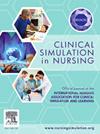Effects of beef tongue and virtual reality in episiotomy training on self-efficacy and anxiety in midwifery students: Randomized controlled trial
IF 2.5
3区 医学
Q1 NURSING
引用次数: 0
Abstract
Background
The application and repair of an episiotomy is a skill that midwifery students must acquire. The type and realism of training methods may influence students' anxiety levels and self-efficacy.
Aim
This study was conducted to evaluate the effects of practice training provided with Beef tongue and virtual reality simulation on students' episiotomy self-efficacy and anxiety levels.
Method
This randomized controlled trial was registered at ClinicalTrials.gov (NCT06711198) and conducted with 95 midwifery students. Participants were allocated to one of three groups—beef tongue simulation (n = 31), virtual reality simulation (n = 32), or a mixed group combining both methods (n = 32)—using block randomization with sealed envelopes, performed by an independent person to ensure balanced group sizes. No blinding was used due to the nature of the interventions. Data were collected using the Student Identification Form, State-Trait Anxiety Inventory, and Episiotomy Self-Efficacy Scale. The study received no external funding.
Results
All training methods significantly improved episiotomy self-efficacy (p < .05), with the greatest improvement in the mixed group. Training also reduced state anxiety (p < .05), with the largest decrease in the beef tongue group, while VR had the least effect on anxiety reduction.
Conclusion
A holistic approach to episiotomy training is essential for skill development. Integrating VR simulations with haptic materials can enhance students' learning by reducing anxiety and improving self-efficacy.
牛舌和虚拟现实在会阴切开术训练中对助产学学生自我效能感和焦虑的影响:随机对照试验
背景外阴切开术的应用和修复是助产学学生必须掌握的技能。训练方法的类型和现实性可能影响学生的焦虑水平和自我效能感。目的探讨牛舌和虚拟现实模拟训练对学生会阴切开术自我效能感和焦虑水平的影响。方法该随机对照试验在ClinicalTrials.gov注册(NCT06711198),共有95名助产学学生参与。参与者被分配到三组中的一组-牛舌模拟(n = 31),虚拟现实模拟(n = 32),或结合两种方法的混合组(n = 32) -使用密封信封的块随机化,由独立人员执行以确保小组规模平衡。由于干预措施的性质,没有使用盲法。数据采用学生识别表、状态-特质焦虑量表和会阴切开术自我效能量表收集。这项研究没有获得外部资助。结果所有训练方法均能显著提高会阴切开术患者的自我效能感(p < 0.05),其中混合训练组的提高幅度最大。训练也减少了状态焦虑(p < 0.05),其中牛舌组的减少幅度最大,而VR对减少焦虑的影响最小。结论全面的外阴切开术训练对技能发展至关重要。将VR模拟与触觉材料相结合,可以通过减少焦虑和提高自我效能感来增强学生的学习效果。
本文章由计算机程序翻译,如有差异,请以英文原文为准。
求助全文
约1分钟内获得全文
求助全文
来源期刊

Clinical Simulation in Nursing
NURSING-
CiteScore
5.50
自引率
15.40%
发文量
107
期刊介绍:
Clinical Simulation in Nursing is an international, peer reviewed journal published online monthly. Clinical Simulation in Nursing is the official journal of the International Nursing Association for Clinical Simulation & Learning (INACSL) and reflects its mission to advance the science of healthcare simulation.
We will review and accept articles from other health provider disciplines, if they are determined to be of interest to our readership. The journal accepts manuscripts meeting one or more of the following criteria:
Research articles and literature reviews (e.g. systematic, scoping, umbrella, integrative, etc.) about simulation
Innovative teaching/learning strategies using simulation
Articles updating guidelines, regulations, and legislative policies that impact simulation
Leadership for simulation
Simulation operations
Clinical and academic uses of simulation.
 求助内容:
求助内容: 应助结果提醒方式:
应助结果提醒方式:


